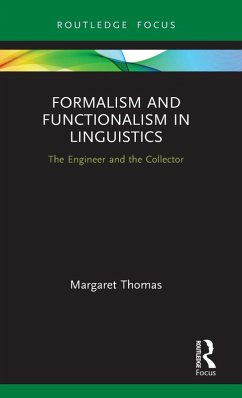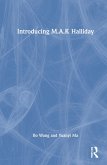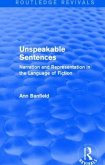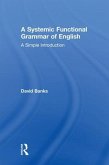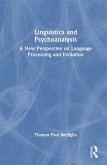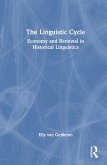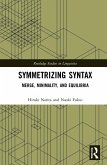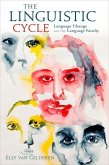- Gebundenes Buch
- Merkliste
- Auf die Merkliste
- Bewerten Bewerten
- Teilen
- Produkt teilen
- Produkterinnerung
- Produkterinnerung
This volume is a concise introduction to the lively ongoing debate between formalist and functionalist approaches to the study of language.
Andere Kunden interessierten sich auch für
![Introducing M.A.K. Halliday Introducing M.A.K. Halliday]() Bo WangIntroducing M.A.K. Halliday168,99 €
Bo WangIntroducing M.A.K. Halliday168,99 €![Unspeakable Sentences (Routledge Revivals) Unspeakable Sentences (Routledge Revivals)]() Ann BanfieldUnspeakable Sentences (Routledge Revivals)190,99 €
Ann BanfieldUnspeakable Sentences (Routledge Revivals)190,99 €![A Systemic Functional Grammar of English A Systemic Functional Grammar of English]() David BanksA Systemic Functional Grammar of English167,99 €
David BanksA Systemic Functional Grammar of English167,99 €![Linguistics and Psychoanalysis Linguistics and Psychoanalysis]() Thomas Paul BonfiglioLinguistics and Psychoanalysis149,99 €
Thomas Paul BonfiglioLinguistics and Psychoanalysis149,99 €![The Linguistic Cycle The Linguistic Cycle]() Elly Van GelderenThe Linguistic Cycle167,99 €
Elly Van GelderenThe Linguistic Cycle167,99 €![Symmetrizing Syntax Symmetrizing Syntax]() Hiroki NaritaSymmetrizing Syntax168,99 €
Hiroki NaritaSymmetrizing Syntax168,99 €![The Linguistic Cycle The Linguistic Cycle]() Elly Van GelderenThe Linguistic Cycle78,99 €
Elly Van GelderenThe Linguistic Cycle78,99 €-
-
-
This volume is a concise introduction to the lively ongoing debate between formalist and functionalist approaches to the study of language.
Produktdetails
- Produktdetails
- Verlag: Routledge
- Seitenzahl: 128
- Erscheinungstermin: 15. August 2019
- Englisch
- Abmessung: 222mm x 145mm x 11mm
- Gewicht: 302g
- ISBN-13: 9781138316119
- ISBN-10: 1138316113
- Artikelnr.: 57496696
- Herstellerkennzeichnung
- Libri GmbH
- Europaallee 1
- 36244 Bad Hersfeld
- gpsr@libri.de
- Verlag: Routledge
- Seitenzahl: 128
- Erscheinungstermin: 15. August 2019
- Englisch
- Abmessung: 222mm x 145mm x 11mm
- Gewicht: 302g
- ISBN-13: 9781138316119
- ISBN-10: 1138316113
- Artikelnr.: 57496696
- Herstellerkennzeichnung
- Libri GmbH
- Europaallee 1
- 36244 Bad Hersfeld
- gpsr@libri.de
Margaret Thomas is Professor of Linguistics in the Department of Slavic and Eastern Languages and Literatures at Boston College, USA.
Table of Contents
Acknowledgements
Introduction
Chapter 1 Defining 'Formalism' and 'Functionalism'
1.1 Starting Out
1.2 Defining the Terms
1.3 The Engineer and the Collector
1.4 Two Examples
1.5 On the Architecture of Formalism Versus Functionalism
References
Chapter 2 Background to the Current Debate
2.1 Is There a Starting Point?
2.2 Before the Twentieth Century
2.3 Twentieth-Century Formalist Linguistics to 1950
2.4 Twentieth-Century Functionalism from the Prague Circle to Pike
2.5 Why the Background Matters
References
Chapter 3 Contemporary Formalist Linguistics
3.1 The Internal Structure of Modern Formalism
3.2 What Makes Modern Formalism Formalist?
3.2.1 Early Transformational Grammar
3.2.2 Principles and Parameters
3.2.3 The Minimalist Program
3.2.4 The Common Formalist Character of Generative Grammar
3.3 Diversity Within Contemporary Formalism
References
Chapter 4 Contemporary Functionalist Linguistics
4.1 The Internal Structure of Modern Functionalism
4.2 The Scope of Modern of Functionalism
4.2.1 Systemic Functional Linguistics
4.2.2 Langacker's Cognitive Grammar
4.2.3 Talmy Givón
4.3 Taxonomies of Modern Functionalist Linguistics
4.4 Graphic Style in Modern Formalism and Functionalism
References
Chapter 5 Formalism and Functionalism in Action
5.1 Applying Formalism and Functionalism
5.2 In the Analysis of Syntactic Phenomena
5.2.1 Word Order
5.2.2 Transitivity
5.3 In Conceptualization and Study of Child Language Learning
5.4 In Debate About the Origin of Human Language
5.5 Gaps, Overlap, and Combat Between Formalism and Functionalism
References
Chapter 6 Formalism and Functionalism Juxtaposed
6.1 Formalism and Functionalism in Silhouette
6.2 Face to Face
6.2.1 In Conversation
6.2.2 How Formal Is Functionalism?
6.2.3 How Functionalist Is Formalism?
6.3 Side by Side
6.3.1 Explanation
6.3.2 (Non)complementarity
6.4 Back to Back
References
Chapter 7 Conclusion
7.1 Engineers and Collectors, Revisited
7.2 Portrait of a Linguistic Mindset
7.3 Formalism and Functionalism Face the World Online
References
Appendix Characteristics of Formalism Versus Functionalism
Index
Acknowledgements
Introduction
Chapter 1 Defining 'Formalism' and 'Functionalism'
1.1 Starting Out
1.2 Defining the Terms
1.3 The Engineer and the Collector
1.4 Two Examples
1.5 On the Architecture of Formalism Versus Functionalism
References
Chapter 2 Background to the Current Debate
2.1 Is There a Starting Point?
2.2 Before the Twentieth Century
2.3 Twentieth-Century Formalist Linguistics to 1950
2.4 Twentieth-Century Functionalism from the Prague Circle to Pike
2.5 Why the Background Matters
References
Chapter 3 Contemporary Formalist Linguistics
3.1 The Internal Structure of Modern Formalism
3.2 What Makes Modern Formalism Formalist?
3.2.1 Early Transformational Grammar
3.2.2 Principles and Parameters
3.2.3 The Minimalist Program
3.2.4 The Common Formalist Character of Generative Grammar
3.3 Diversity Within Contemporary Formalism
References
Chapter 4 Contemporary Functionalist Linguistics
4.1 The Internal Structure of Modern Functionalism
4.2 The Scope of Modern of Functionalism
4.2.1 Systemic Functional Linguistics
4.2.2 Langacker's Cognitive Grammar
4.2.3 Talmy Givón
4.3 Taxonomies of Modern Functionalist Linguistics
4.4 Graphic Style in Modern Formalism and Functionalism
References
Chapter 5 Formalism and Functionalism in Action
5.1 Applying Formalism and Functionalism
5.2 In the Analysis of Syntactic Phenomena
5.2.1 Word Order
5.2.2 Transitivity
5.3 In Conceptualization and Study of Child Language Learning
5.4 In Debate About the Origin of Human Language
5.5 Gaps, Overlap, and Combat Between Formalism and Functionalism
References
Chapter 6 Formalism and Functionalism Juxtaposed
6.1 Formalism and Functionalism in Silhouette
6.2 Face to Face
6.2.1 In Conversation
6.2.2 How Formal Is Functionalism?
6.2.3 How Functionalist Is Formalism?
6.3 Side by Side
6.3.1 Explanation
6.3.2 (Non)complementarity
6.4 Back to Back
References
Chapter 7 Conclusion
7.1 Engineers and Collectors, Revisited
7.2 Portrait of a Linguistic Mindset
7.3 Formalism and Functionalism Face the World Online
References
Appendix Characteristics of Formalism Versus Functionalism
Index
Table of Contents
Acknowledgements
Introduction
Chapter 1 Defining 'Formalism' and 'Functionalism'
1.1 Starting Out
1.2 Defining the Terms
1.3 The Engineer and the Collector
1.4 Two Examples
1.5 On the Architecture of Formalism Versus Functionalism
References
Chapter 2 Background to the Current Debate
2.1 Is There a Starting Point?
2.2 Before the Twentieth Century
2.3 Twentieth-Century Formalist Linguistics to 1950
2.4 Twentieth-Century Functionalism from the Prague Circle to Pike
2.5 Why the Background Matters
References
Chapter 3 Contemporary Formalist Linguistics
3.1 The Internal Structure of Modern Formalism
3.2 What Makes Modern Formalism Formalist?
3.2.1 Early Transformational Grammar
3.2.2 Principles and Parameters
3.2.3 The Minimalist Program
3.2.4 The Common Formalist Character of Generative Grammar
3.3 Diversity Within Contemporary Formalism
References
Chapter 4 Contemporary Functionalist Linguistics
4.1 The Internal Structure of Modern Functionalism
4.2 The Scope of Modern of Functionalism
4.2.1 Systemic Functional Linguistics
4.2.2 Langacker's Cognitive Grammar
4.2.3 Talmy Givón
4.3 Taxonomies of Modern Functionalist Linguistics
4.4 Graphic Style in Modern Formalism and Functionalism
References
Chapter 5 Formalism and Functionalism in Action
5.1 Applying Formalism and Functionalism
5.2 In the Analysis of Syntactic Phenomena
5.2.1 Word Order
5.2.2 Transitivity
5.3 In Conceptualization and Study of Child Language Learning
5.4 In Debate About the Origin of Human Language
5.5 Gaps, Overlap, and Combat Between Formalism and Functionalism
References
Chapter 6 Formalism and Functionalism Juxtaposed
6.1 Formalism and Functionalism in Silhouette
6.2 Face to Face
6.2.1 In Conversation
6.2.2 How Formal Is Functionalism?
6.2.3 How Functionalist Is Formalism?
6.3 Side by Side
6.3.1 Explanation
6.3.2 (Non)complementarity
6.4 Back to Back
References
Chapter 7 Conclusion
7.1 Engineers and Collectors, Revisited
7.2 Portrait of a Linguistic Mindset
7.3 Formalism and Functionalism Face the World Online
References
Appendix Characteristics of Formalism Versus Functionalism
Index
Acknowledgements
Introduction
Chapter 1 Defining 'Formalism' and 'Functionalism'
1.1 Starting Out
1.2 Defining the Terms
1.3 The Engineer and the Collector
1.4 Two Examples
1.5 On the Architecture of Formalism Versus Functionalism
References
Chapter 2 Background to the Current Debate
2.1 Is There a Starting Point?
2.2 Before the Twentieth Century
2.3 Twentieth-Century Formalist Linguistics to 1950
2.4 Twentieth-Century Functionalism from the Prague Circle to Pike
2.5 Why the Background Matters
References
Chapter 3 Contemporary Formalist Linguistics
3.1 The Internal Structure of Modern Formalism
3.2 What Makes Modern Formalism Formalist?
3.2.1 Early Transformational Grammar
3.2.2 Principles and Parameters
3.2.3 The Minimalist Program
3.2.4 The Common Formalist Character of Generative Grammar
3.3 Diversity Within Contemporary Formalism
References
Chapter 4 Contemporary Functionalist Linguistics
4.1 The Internal Structure of Modern Functionalism
4.2 The Scope of Modern of Functionalism
4.2.1 Systemic Functional Linguistics
4.2.2 Langacker's Cognitive Grammar
4.2.3 Talmy Givón
4.3 Taxonomies of Modern Functionalist Linguistics
4.4 Graphic Style in Modern Formalism and Functionalism
References
Chapter 5 Formalism and Functionalism in Action
5.1 Applying Formalism and Functionalism
5.2 In the Analysis of Syntactic Phenomena
5.2.1 Word Order
5.2.2 Transitivity
5.3 In Conceptualization and Study of Child Language Learning
5.4 In Debate About the Origin of Human Language
5.5 Gaps, Overlap, and Combat Between Formalism and Functionalism
References
Chapter 6 Formalism and Functionalism Juxtaposed
6.1 Formalism and Functionalism in Silhouette
6.2 Face to Face
6.2.1 In Conversation
6.2.2 How Formal Is Functionalism?
6.2.3 How Functionalist Is Formalism?
6.3 Side by Side
6.3.1 Explanation
6.3.2 (Non)complementarity
6.4 Back to Back
References
Chapter 7 Conclusion
7.1 Engineers and Collectors, Revisited
7.2 Portrait of a Linguistic Mindset
7.3 Formalism and Functionalism Face the World Online
References
Appendix Characteristics of Formalism Versus Functionalism
Index
Table of Contents
Acknowledgements
Introduction
Chapter 1 Defining 'Formalism' and 'Functionalism'
1.1 Starting Out
1.2 Defining the Terms
1.3 The Engineer and the Collector
1.4 Two Examples
1.5 On the Architecture of Formalism Versus Functionalism
References
Chapter 2 Background to the Current Debate
2.1 Is There a Starting Point?
2.2 Before the Twentieth Century
2.3 Twentieth-Century Formalist Linguistics to 1950
2.4 Twentieth-Century Functionalism from the Prague Circle to Pike
2.5 Why the Background Matters
References
Chapter 3 Contemporary Formalist Linguistics
3.1 The Internal Structure of Modern Formalism
3.2 What Makes Modern Formalism Formalist?
3.2.1 Early Transformational Grammar
3.2.2 Principles and Parameters
3.2.3 The Minimalist Program
3.2.4 The Common Formalist Character of Generative Grammar
3.3 Diversity Within Contemporary Formalism
References
Chapter 4 Contemporary Functionalist Linguistics
4.1 The Internal Structure of Modern Functionalism
4.2 The Scope of Modern of Functionalism
4.2.1 Systemic Functional Linguistics
4.2.2 Langacker's Cognitive Grammar
4.2.3 Talmy Givón
4.3 Taxonomies of Modern Functionalist Linguistics
4.4 Graphic Style in Modern Formalism and Functionalism
References
Chapter 5 Formalism and Functionalism in Action
5.1 Applying Formalism and Functionalism
5.2 In the Analysis of Syntactic Phenomena
5.2.1 Word Order
5.2.2 Transitivity
5.3 In Conceptualization and Study of Child Language Learning
5.4 In Debate About the Origin of Human Language
5.5 Gaps, Overlap, and Combat Between Formalism and Functionalism
References
Chapter 6 Formalism and Functionalism Juxtaposed
6.1 Formalism and Functionalism in Silhouette
6.2 Face to Face
6.2.1 In Conversation
6.2.2 How Formal Is Functionalism?
6.2.3 How Functionalist Is Formalism?
6.3 Side by Side
6.3.1 Explanation
6.3.2 (Non)complementarity
6.4 Back to Back
References
Chapter 7 Conclusion
7.1 Engineers and Collectors, Revisited
7.2 Portrait of a Linguistic Mindset
7.3 Formalism and Functionalism Face the World Online
References
Appendix Characteristics of Formalism Versus Functionalism
Index
Acknowledgements
Introduction
Chapter 1 Defining 'Formalism' and 'Functionalism'
1.1 Starting Out
1.2 Defining the Terms
1.3 The Engineer and the Collector
1.4 Two Examples
1.5 On the Architecture of Formalism Versus Functionalism
References
Chapter 2 Background to the Current Debate
2.1 Is There a Starting Point?
2.2 Before the Twentieth Century
2.3 Twentieth-Century Formalist Linguistics to 1950
2.4 Twentieth-Century Functionalism from the Prague Circle to Pike
2.5 Why the Background Matters
References
Chapter 3 Contemporary Formalist Linguistics
3.1 The Internal Structure of Modern Formalism
3.2 What Makes Modern Formalism Formalist?
3.2.1 Early Transformational Grammar
3.2.2 Principles and Parameters
3.2.3 The Minimalist Program
3.2.4 The Common Formalist Character of Generative Grammar
3.3 Diversity Within Contemporary Formalism
References
Chapter 4 Contemporary Functionalist Linguistics
4.1 The Internal Structure of Modern Functionalism
4.2 The Scope of Modern of Functionalism
4.2.1 Systemic Functional Linguistics
4.2.2 Langacker's Cognitive Grammar
4.2.3 Talmy Givón
4.3 Taxonomies of Modern Functionalist Linguistics
4.4 Graphic Style in Modern Formalism and Functionalism
References
Chapter 5 Formalism and Functionalism in Action
5.1 Applying Formalism and Functionalism
5.2 In the Analysis of Syntactic Phenomena
5.2.1 Word Order
5.2.2 Transitivity
5.3 In Conceptualization and Study of Child Language Learning
5.4 In Debate About the Origin of Human Language
5.5 Gaps, Overlap, and Combat Between Formalism and Functionalism
References
Chapter 6 Formalism and Functionalism Juxtaposed
6.1 Formalism and Functionalism in Silhouette
6.2 Face to Face
6.2.1 In Conversation
6.2.2 How Formal Is Functionalism?
6.2.3 How Functionalist Is Formalism?
6.3 Side by Side
6.3.1 Explanation
6.3.2 (Non)complementarity
6.4 Back to Back
References
Chapter 7 Conclusion
7.1 Engineers and Collectors, Revisited
7.2 Portrait of a Linguistic Mindset
7.3 Formalism and Functionalism Face the World Online
References
Appendix Characteristics of Formalism Versus Functionalism
Index
Table of Contents
Acknowledgements
Introduction
Chapter 1 Defining 'Formalism' and 'Functionalism'
1.1 Starting Out
1.2 Defining the Terms
1.3 The Engineer and the Collector
1.4 Two Examples
1.5 On the Architecture of Formalism Versus Functionalism
References
Chapter 2 Background to the Current Debate
2.1 Is There a Starting Point?
2.2 Before the Twentieth Century
2.3 Twentieth-Century Formalist Linguistics to 1950
2.4 Twentieth-Century Functionalism from the Prague Circle to Pike
2.5 Why the Background Matters
References
Chapter 3 Contemporary Formalist Linguistics
3.1 The Internal Structure of Modern Formalism
3.2 What Makes Modern Formalism Formalist?
3.2.1 Early Transformational Grammar
3.2.2 Principles and Parameters
3.2.3 The Minimalist Program
3.2.4 The Common Formalist Character of Generative Grammar
3.3 Diversity Within Contemporary Formalism
References
Chapter 4 Contemporary Functionalist Linguistics
4.1 The Internal Structure of Modern Functionalism
4.2 The Scope of Modern of Functionalism
4.2.1 Systemic Functional Linguistics
4.2.2 Langacker's Cognitive Grammar
4.2.3 Talmy Givón
4.3 Taxonomies of Modern Functionalist Linguistics
4.4 Graphic Style in Modern Formalism and Functionalism
References
Chapter 5 Formalism and Functionalism in Action
5.1 Applying Formalism and Functionalism
5.2 In the Analysis of Syntactic Phenomena
5.2.1 Word Order
5.2.2 Transitivity
5.3 In Conceptualization and Study of Child Language Learning
5.4 In Debate About the Origin of Human Language
5.5 Gaps, Overlap, and Combat Between Formalism and Functionalism
References
Chapter 6 Formalism and Functionalism Juxtaposed
6.1 Formalism and Functionalism in Silhouette
6.2 Face to Face
6.2.1 In Conversation
6.2.2 How Formal Is Functionalism?
6.2.3 How Functionalist Is Formalism?
6.3 Side by Side
6.3.1 Explanation
6.3.2 (Non)complementarity
6.4 Back to Back
References
Chapter 7 Conclusion
7.1 Engineers and Collectors, Revisited
7.2 Portrait of a Linguistic Mindset
7.3 Formalism and Functionalism Face the World Online
References
Appendix Characteristics of Formalism Versus Functionalism
Index
Acknowledgements
Introduction
Chapter 1 Defining 'Formalism' and 'Functionalism'
1.1 Starting Out
1.2 Defining the Terms
1.3 The Engineer and the Collector
1.4 Two Examples
1.5 On the Architecture of Formalism Versus Functionalism
References
Chapter 2 Background to the Current Debate
2.1 Is There a Starting Point?
2.2 Before the Twentieth Century
2.3 Twentieth-Century Formalist Linguistics to 1950
2.4 Twentieth-Century Functionalism from the Prague Circle to Pike
2.5 Why the Background Matters
References
Chapter 3 Contemporary Formalist Linguistics
3.1 The Internal Structure of Modern Formalism
3.2 What Makes Modern Formalism Formalist?
3.2.1 Early Transformational Grammar
3.2.2 Principles and Parameters
3.2.3 The Minimalist Program
3.2.4 The Common Formalist Character of Generative Grammar
3.3 Diversity Within Contemporary Formalism
References
Chapter 4 Contemporary Functionalist Linguistics
4.1 The Internal Structure of Modern Functionalism
4.2 The Scope of Modern of Functionalism
4.2.1 Systemic Functional Linguistics
4.2.2 Langacker's Cognitive Grammar
4.2.3 Talmy Givón
4.3 Taxonomies of Modern Functionalist Linguistics
4.4 Graphic Style in Modern Formalism and Functionalism
References
Chapter 5 Formalism and Functionalism in Action
5.1 Applying Formalism and Functionalism
5.2 In the Analysis of Syntactic Phenomena
5.2.1 Word Order
5.2.2 Transitivity
5.3 In Conceptualization and Study of Child Language Learning
5.4 In Debate About the Origin of Human Language
5.5 Gaps, Overlap, and Combat Between Formalism and Functionalism
References
Chapter 6 Formalism and Functionalism Juxtaposed
6.1 Formalism and Functionalism in Silhouette
6.2 Face to Face
6.2.1 In Conversation
6.2.2 How Formal Is Functionalism?
6.2.3 How Functionalist Is Formalism?
6.3 Side by Side
6.3.1 Explanation
6.3.2 (Non)complementarity
6.4 Back to Back
References
Chapter 7 Conclusion
7.1 Engineers and Collectors, Revisited
7.2 Portrait of a Linguistic Mindset
7.3 Formalism and Functionalism Face the World Online
References
Appendix Characteristics of Formalism Versus Functionalism
Index

